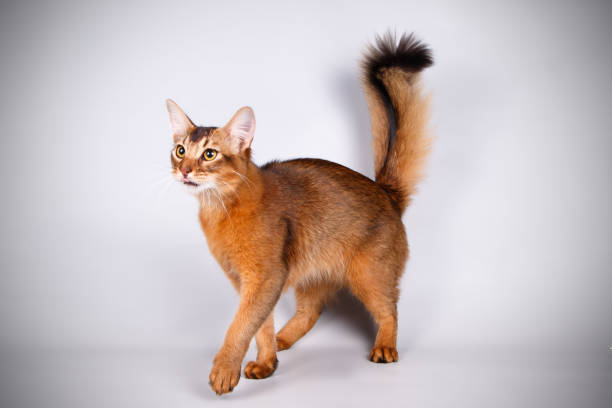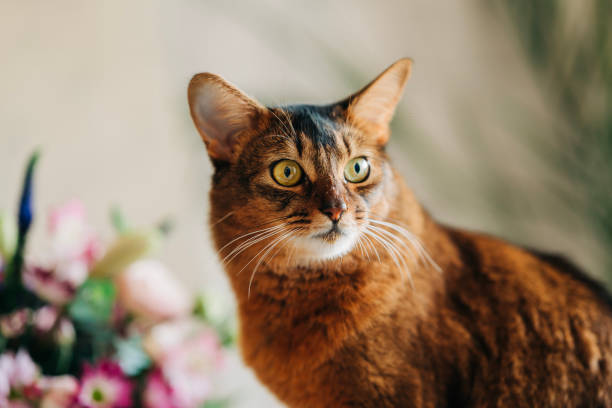Somali cat

History:
The Somali cat is often described as the long-haired cousin of the Abyssinian, sharing its vibrant personality and ticked coat. Its origins date back to the 1940s and 1950s, when longhaired kittens occasionally appeared in Abyssinian litters. Initially seen as an anomaly, these kittens were eventually recognised as a distinct breed, thanks in part to breeders like Evelyn Mague in the United States who championed their unique beauty. By the 1970s, the breed was named “Somali,” evoking the exotic and wild look reminiscent of African wildlife. Despite the name, the breed is not from Somalia but developed through careful breeding in the U.S., Canada, Australia, and Europe. The Somali cat has since gained recognition for its fox-like appearance, intelligence, and engaging temperament.
Size: Medium-sized cat
Height: 20–25 cm
Weight: 3–5.5 kg
Life Expectancy: 12 to 16 years

Breed Appearance:
The Somali cat is a graceful and athletic feline with a medium build and muscular frame. Its most striking feature is its semi-long, soft coat with a distinctive ticked pattern, where each hair has multiple bands of colour. This gives the cat a warm, glowing look, often in shades like ruddy, red, blue, or fawn. The Somali has a slightly wedge-shaped head with large, alert ears, almond-shaped eyes that can be gold, green, or hazel, and a smiling expression. Its long, bushy tail and tufted ears give it a fox-like appearance. The coat is soft and fine, with a ruff around the neck and breeches on the hind legs that enhance its elegant silhouette.
Health & Care:
Somalis are generally healthy cats, but they can be predisposed to a few hereditary issues, including gingivitis, pyruvate kinase deficiency (an inherited anaemia), and progressive retinal atrophy (PRA). Responsible breeders screen for these conditions. Their semi-long coat doesn’t mat easily but does benefit from brushing twice a week to remove loose hair and prevent tangles. Dental care, regular vet visits, and a high-protein diet help maintain their health and vitality. Their active and curious nature also makes exercise and mental stimulation essential to prevent boredom and stress-related behaviour.

Living Conditions:
Somali cats thrive in interactive households where they receive plenty of attention and stimulation. They do well in both apartments and larger homes as long as there’s room to climb and explore. These intelligent cats enjoy playing with puzzle toys, climbing cat trees, and even learning tricks. They are highly social and enjoy the company of humans and other pets. While not clingy, they prefer being part of daily family activities. Left alone too long, they may become restless or lonely, so companionship—whether from humans or other pets—is important for their well-being.
Grooming:
The Somali’s semi-long coat is relatively low-maintenance, thanks to its fine texture and lack of an undercoat. Brushing twice a week helps keep it looking clean and prevents tangles or shedding. More grooming may be needed during seasonal moults. Their care regimen should include routine nail trimming, ear checks, and dental hygiene. They rarely need bathing, but if done, a gentle cat shampoo should be used. With regular care, their rich, ticked coat remains striking and healthy, and their grooming routine is easy for most cat owners to manage.

Advantages:
-
Somali cats are intelligent, playful, and interactive companions that form strong bonds with their families.
-
Their striking coat and expressive features give them a wild, fox-like charm that stands out in any home.
-
They are highly agile and love to climb and explore, making them entertaining pets for active households.
-
Their coat is relatively easy to groom despite its length, requiring only moderate maintenance.
-
They are typically friendly with other pets and children, adapting well to multi-pet or family environments.
Disadvantages:
-
Somalis dislike being bored or left alone for long periods and may develop behavioural issues without enough stimulation.
-
Their high energy and intelligence require consistent engagement—owners must be prepared to provide toys, playtime, and attention.
-
They may be prone to inherited health conditions like PRA or anaemia, so careful breeding and regular vet care are essential.
-
Their curiosity can lead to mischief, such as opening cupboards or climbing where they shouldn’t.
-
While not excessively vocal, they may "talk" with chirps or meows when seeking interaction or expressing curiosity.







